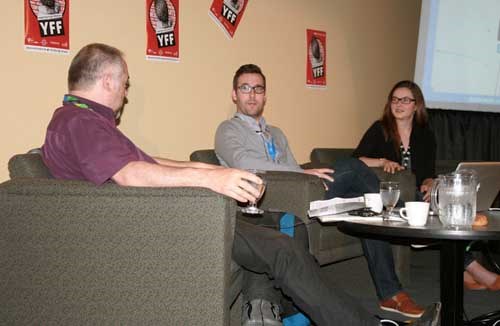When it came to making Indie Game: The Movie filmmakers Lisanne Pajot and James Swirsky went down unconventional paths with just about every aspect of its funding and release, and they all worked.
The movie was one of the first films to be born on Kickstarter. The film was funded in part by two successful crowd-funding campaigns. It premiered at the Sundance Film Festival in 2012, where it won the Best Editing Award in World Documentary Cinema and was optioned by HBO and Scott Rudin.
The filmmakers chose to self-release Indie Game: The Movie in several innovative ways. They organized a 15 city, in-person US tour, presented by Adobe.
Soon after the theatrical opening, Indie Game: The Movie released world-wide on iTunes, topping the charts at number one in documentaries and number 14 of all movies. It was first feature film released on Steam, one of the world's biggest gaming platforms.
Indie Game: The Movie is a New York Times Critics' Pick and one of top reviewed movies of 2012 on Rotten Tomatoes. It has been selected for many festivals including SXSW, the Game Developers Conference, Hot Docs and Sheffield Doc/Fest. The film continues to screen all over the world and is available in 20 languages.
So it was a near full house when the filmmakers joined moderator Daniel Cross for a workshop on what they did.
Swirsky said the idea of crowd funding through the then fledgling Kickstarter, an Internet location where people can support movies, comics, games and other projects in development, was seen as both a way to gain funding, and to gauge interest in their story.
"Let's put stuff there and see if people want it," he reasoned.
Since the movie was about indie video game developers, Swirsky said they had an idea of their potential audience, under 25 gamers.
"So let's go to the Internet and ask them," he said.
Swirsky added funding was something they were not sure how to raise.
"We knew how to make video but we'd never pitched a movie," he said.
So the filmmakers made a test piece and went to the web with a modest $15,000 goal on Kickstarter, "so we could get in a car and drive around North America to shoot this film," said Pajot, adding they figured they'd find a funding source for the rest of the process.
And the gaming world responded.
"We made our goal in 48 hours," said Pajot, who said there was something inspiring about 300 people from around the world willing to give their project $15,000. " People cared about what we were doing."
And as people funded the project, they became instant fans too.
"We were building our audience as we were shooting the film," said Pajot.
So the filmmakers fed their growing community posting 88-minutes of content "before the film came out." The finished film is 94-minutes.
The process of releasing additional minutes added to the film workload though.
"It made everything more of a pressure cooker creatively," said Pajot, adding they were ending up with thousands of fans all over the world, under 20, and all having an opinion.
But it also kept things on track, said Swirsky.
"It forced us to get the film done faster," he said.
Swirsky said the film itself really turned out to be reflective of their efforts. They were like the indie game developers struggling to get their project done and out to the public.
In that regard "the heart of the movie, a lot of it was inspired by the developers themselves," he offered, adding on a film basis Indie Game worked because the developers were so willing "to share their vision."
Swirsky said for both the game developers and themselves making the film, the effort became all encompassing.
"It just takes over your lives," he said.
For an indie film the world premier was at the prestigios Sundance.
Pajot said as soon as the film was associated with the festival, there was interest from agents and others. They received 1500 email the day it was announced and 1000 the next.
But the Winnipeg-based filmmakers wanted to hold onto control, especially in terms of digital distribution.
"We had this gut feeling it would do well online," she said.
So after a theatrical release with Adobe financing the run, the filmmakers made the worldwide release of the film, going for sale through the website, iTunes and Steam on the same day.
Pajot said they saw Steam, as a major gaming platform, as a key release outlet since game players were an obvious fan base for the film.
The simultaneous digital release was one way to reduce the threat of piracy.
Swirsky many pirate "not because they want to pirate it, but because they want to see it so bad," so having it easily available for paid download was important.
The pair said the way they went about Indie Game: The Movie, it ended up more a business than a film.
And it continues.
Swirsky said they are at work now on a special edition for supporters from back on the Kickstarter launch. The edition will be a three-disk set with 250-minutes of content.




